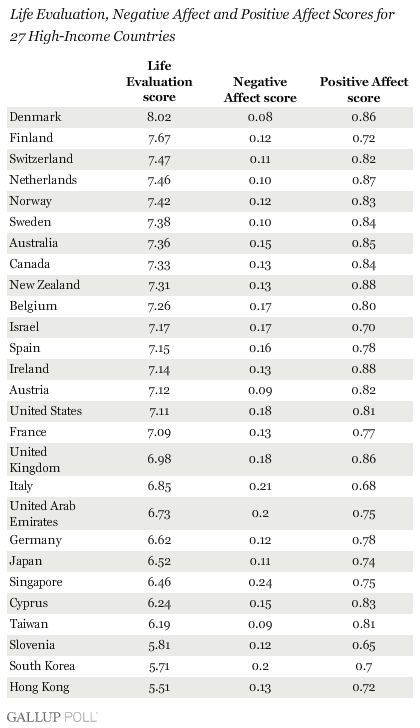WASHINGTON, D.C. -- The French President Nicolas Sarkozy announced last week a government initiative to measure happiness in the country, noting "the growing gap between statistics that show continuing progress and the increasing difficulties (French people) are having in their daily lives." In fact, ���۴�ýresearch shows that the report card on French citizens' well-being is not particularly glowing. French responses on measures of life satisfaction and their daily experiences are quite average when compared with happiness levels among residents in other high-income countries.
The French government is not breaking new ground in placing an emphasis on a broader set of indicators to measure the country's progress. Richard Easterlin in a landmark 1974 paper "Does Economic Growth Improve the Human Lot?" showed conclusively that beyond a point increases in per-capital income are not accompanied by increases in happiness. This made a strong case for governments and development agencies to look beyond purely income-based indicators of development. For example, Bhutan famously pioneered the idea of Gross National Happiness as a counterpoint to GNP. And, the United Nations primarily created the Human Development Index in 1990 to shift the dialogue away from income-based measures of development. In the UK, the idea of increasing national well-being is a key part of government rhetoric with the Department for Environment, Food, and Rural Affairs (Defra), leading the effort to design national indicators of well-being.
Through its polling in more than 130 nations and areas, ���۴�ýis building one of the most comprehensive databases of subjective well-being measures in the world. The poll provides insight into people's perception of their happiness, their moods and feelings, their satisfaction with various life domains (work, marriage, standard of living, health), and their rating of their communities, cities, public institutions, and governments. Gallup's measures of well-being were developed with extensive input from Nobel laureate Daniel Kahneman and University of Illinois psychology professor Ed Diener, a pioneer in the field of well-being research.
These measures are unique because they include both a broad indicator of life satisfaction or "evaluative well-being" as well as a more objective/"experiencing self" component. Life satisfaction is measured using a question that represents life as a ladder with steps numbered from 0 to 10, where "0" indicates the worst life possible and "10" the best possible life, also known as the Cantril Self-Anchoring Striving Scale. The "experiencing self" questions, on the other hand, are a series of questions that relate to experiences of positive and negative affect in a more immediate time frame (the past 24 hours), and in doing so are less prone to the effects of memory and judgment. (Positive Affect is defined as the average of the yesterday items measuring smiling/laughter and enjoyment; Negative Affect is defined by the average response to the yesterday items measuring sadness and depression.)

In relation to residents in comparable high per-capita income countries, French citizens express average levels of life satisfaction and average levels of negative affect and positive affect. We know from the work of professor Angus Deaton that per-capita GDP and average national life-satisfaction levels are highly correlated, and in this context it is perfectly reasonable to find France displaying average levels of life satisfaction. Measures of affect are far less related to GDP, however, and in this area the French scores are lackluster. If indeed the French government is interested in increasing national happiness, it would do well to focus its efforts on improving levels of positive affect in the country. Policy initiatives aimed at improving positive affect need to be local in nature with the aim of impacting the day-to-day life of people, for instance, their jobs, time spent commuting to work, how they arrange for child care, and how they spend their leisure time.
Survey Methods
Results are based on telephone and face-to-face interviews conducted throughout 2005. Randomly selected sample sizes typically number 1,000 residents, aged 15 and older, in the countries polled. For results based on samples of this size, one can say with 95% confidence that the maximum error attributable to sampling and other random effects is ±3 percentage points. In addition to sampling error, question wording and practical difficulties in conducting surveys can introduce error or bias into the findings of public opinion polls.
